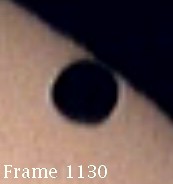
Prior to the transit of Venus in 1761, Edmond Halley and Joseph-Nicolas Delisle developed methods of determining the distance between the Earth and the Sun using transit observations. The method required precise timings of the moment in time that the limb of the black silhouette of Venus touched the limb of the Sun. The images shown here depict Venus approaching the limb of the Sun as the planet made its egress from the face of the Sun. The moment that the disk of Venus touches the limb of the Sun in this instance is called "third contact."
The attempts at timing the transits in 1761, 1769, 1874 and 1882 encountered difficulties in achieving precise timings due to the "black-drop effect." During second and third contact, the planet's silhouette would appear distended like a drop of water about to drip from a faucet. This above image shows individual frames from video captured during the June 8, 2004 transit. The individual frames are in the order in which they appear in the video recorded just before third contact, i.e., as Venus was about to leave the face of the Sun. In the above frames, the disk of Venus appears to have made contact with the limb of the Sun, and the black silhouette of Venus appears to join with the black area off of the face of the Sun. It would appear that third contact has occurred, and an observer might record the time that these images were observed as the time of the third contact.
However, the image below shows a subsequent frame from the same video. Looking closely at this image, it would appear that third contact has not yet occurred. In this frame, the black silhouette of Venus has not yet touched the limb of the Sun. This phenomenon made the methods of determining the Earth-Sun distance using transit timings difficult to apply in practice. Nevertheless, Johann Franz Encke derived a value of the Earth-Sun distance from transit timings made during the 1761 and 1769 transits that was within 3 percent of the actual value. David Gill, who observed the 1874 transit of Venus with Lord James Ludovic Lindsay on Mauritius Island, produced a value of the Earth-Sun distance that was accurate to within 0.2 percent.

The above images were taken with a ToUcam web cam on a Takahashi FS-78 refractor at prime focus with a solar filter over the telescope. The FS-78 has a focal length of 630 mm and an aperture of 78 mm. The frames of the video were captured at a rate of 30 frames per second, using a shutter speed of 1/500 second.
I traveled to Mauritius to observe the 2004 transit from the same site that historic observations were made during the 1874 transit. I also had an opportunity to meet Lord Lindsay's great great grandson, who also traveled to Mauritius for the event.
The Sun & Venus
June 8, 2004
Image by Sid Leach
Mauritius Island
Recent Images.
Complete list of images.
Description of equipment used to acquire images.
Home
Feedback and comments should go to Sid